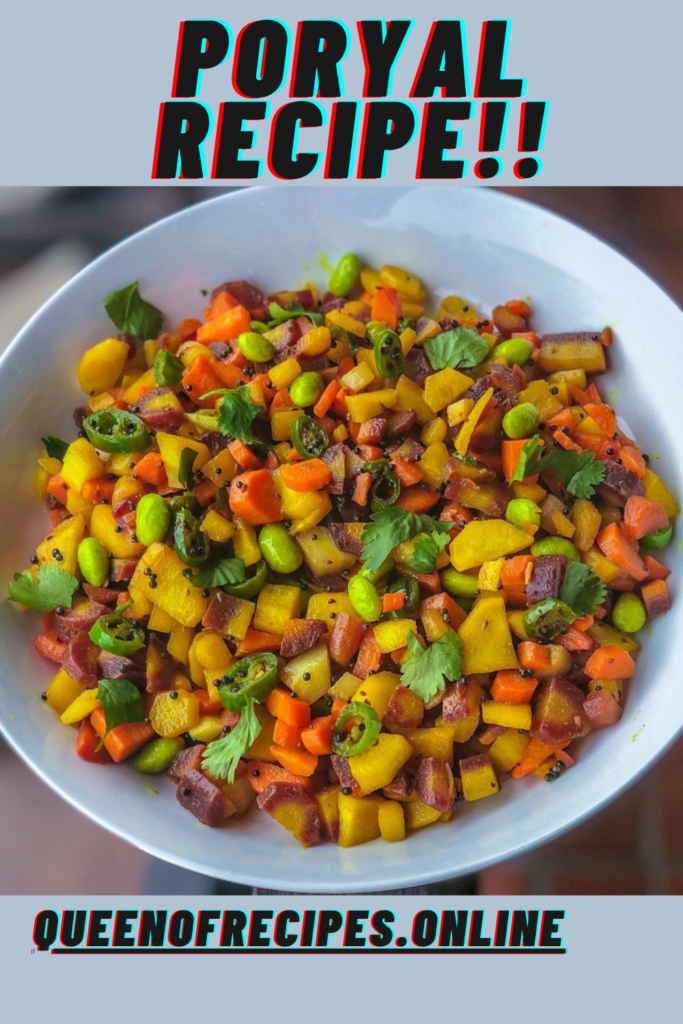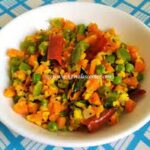Table of Contents
About Poriyal
Poriyal is a popular dish from South Indian Platter, that is made with a variety of vegetables that are lightly sautéed with spices and grated coconut. It is a simple and flavorful food item that is typically served as a side dish with rice, sambar or rasam.
The origins of Poriyal can be traced back to the southern state of Tamil Nadu, where it is a staple in most households. It is believed to have been created as a way to use up leftover veggies and has since become a beloved food item in many parts of South India.
One of the unique aspects of this dish is the variety of vegetables used in the recipe. Popular veggies include carrots, beans, cabbage, beetroot, and even bitter gourd, but the combination of veggies can vary depending on availability and personal preference. The addition of grated coconut adds a subtle sweetness and a unique texture to the food, while the spices like mustard seeds, cumin seeds, and red chili provide a burst of flavor.
Apart from its delicious taste, Poriyal is also a healthy and nutritious dish that is low in calories and high in essential vitamins and minerals. The combination of vegetables and coconut provides a range of nutrients like fiber, vitamins, and minerals. Overall, Poriyal is a simple, yet flavorful and nutritious food item that is an essential part of South Indian cuisine.
Poriyal is a South Indian dish that is made with a variety of vegetables that are seasoned with spices and grated coconut. It is typically served as a side food item with rice and sambar or rasam. Here is a recipe for making delicious Poriyal at home:
Ingredients for making Poriyal:
- 2 cups chopped mixed veggies carrots, beans, cabbage, beetroot, etc.)
- 1/4 cup grated coconut
- 1 teaspoon mustard seeds
- 1 teaspoon cumin seeds
- 2-3 dried red chilies
- 1/2 teaspoon turmeric powder
- 1 tablespoon coconut oil
- Salt to taste
Instructions:
- Heat the coconut oil in a large pan or wok over medium heat.
- Add the mustard seeds and cumin seeds and let them splutter for a few seconds.
- Add the dried red chilies and sauté for a few seconds.
- Add the chopped veggies and stir well.
- Add the turmeric powder and salt and mix well.
- Cover the pan with a lid and cook the vegetables for 5-7 minutes, stirring occasionally, until they are cooked but still retain their crunchiness.
- Add the grated coconut to the pan and mix well.
- Cook for a couple of minutes until the coconut is lightly toasted.
- Turn off the heat and serve hot.
Enjoy your delicious home-made Poriyal with rice and sambar or rasam.


Nutritional value
Poriyal is a nutritious dish that is made with a variety of vegetables and coconut, which provide a range of essential vitamins, minerals, and dietary fiber. Here are some of the key nutrients that Poriyal can offer:
- Carbohydrates: Poriyal is primarily made with vegetables, which are a good source of carbohydrates. A serving of Poriyal can provide around 15-20 grams of carbohydrates.
- Fiber: The vegetables used in Poriyal are a rich source of dietary fiber, which can aid digestion and promote satiety. A serving of Poriyal can provide around 5-7 grams of fiber.
- Vitamins: Poriyal is rich in several vitamins, including vitamin A from carrots and beetroot, vitamin C from cabbage and beans, and vitamin K from green leafy vegetables.
- Minerals: Poriyal contains several essential minerals like potassium, magnesium, and calcium from the veggies and coconut used in the recipe.
- Healthy fats: The grated coconut used provides healthy fats, including medium-chain triglycerides (MCTs), which are easily digested and can provide energy to the body.
Overall, Poriyal is a healthy and nutritious food item that can provide a range of essential nutrients to the body. However, the nutritional value can vary depending on the type and quantity of vegetables used. It is best to use fresh and seasonal vegetables to maximize the nutritional benefits of the dish.
Health Benefits
It offers several health benefits due to its nutritious ingredients and cooking methods. Here are some potential health benefits of eating poriyal:
- Nutrient-Rich: Poriyal typically contains a variety of vegetables, such as carrots, beans, cabbage, or spinach. These vegetables are rich in essential vitamins, minerals, and dietary fiber, providing a wide array of nutrients that contribute to overall health and well-being.
- High in Fiber: Poriyal’s emphasis on vegetables means it is typically high in dietary fiber. Fiber aids in digestion, promotes satiety, and helps regulate blood sugar levels. It also supports a healthy gut microbiome and can contribute to weight management.
- Antioxidant Content: Many vegetables used in poriyal, such as carrots, spinach, and cabbage, are rich in antioxidants. Antioxidants help protect the body against harmful free radicals, reducing the risk of chronic diseases and supporting a healthy immune system.
- Low in Calories: Poriyal is generally a low-calorie dish, especially when cooked with minimal oil or added fats. It can be a satisfying addition to meals while providing important nutrients and flavors without significantly increasing caloric intake.
- Versatile and Customizable: Poriyal can be customized to incorporate a variety of vegetables and spices, allowing for a diverse range of flavors and nutritional benefits. The versatility of poriyal ensures that it can be adapted to suit individual preferences and dietary needs.
Incorporating poriyal as part of a balanced and varied diet can contribute to a nutrient-rich meal, providing essential vitamins, minerals, fiber, and antioxidants that support overall health and well-being.
Tips and Tricks
Poriyal is a South Indian stir-fry dish made with vegetables, coconut, and spices. It’s a flavorful and nutritious side dish that can be served with rice or Indian bread. Here are some tips and tricks to make delicious poriyal:
- Choose Fresh Vegetables: Use fresh and seasonal vegetables for the best taste and texture. Common choices for poriyal include beans, carrots, cabbage, okra, spinach, and zucchini.
- Uniform Cutting: Cut the vegetables into uniform sizes and shapes to ensure even cooking. This helps in achieving a consistent texture and appearance in the final dish.
- Precook Dense Vegetables: Some vegetables, like carrots and beans, can be slightly precooked before stir-frying to ensure they are tender without overcooking the more delicate ones like spinach or zucchini. You can blanch or steam denser vegetables briefly before stir-frying.
- Dry Roast Spices: Dry roast whole spices like mustard seeds, cumin seeds, and urad dal in a pan before adding oil to enhance their flavors.
- Use Fresh Coconut: Grate fresh coconut or use frozen grated coconut for the best taste. It adds a pleasant sweetness and texture to the dish.
- Tempering: Heat oil and add mustard seeds and urad dal for tempering. The crackling of mustard seeds and the aroma of urad dal in hot oil add depth to the flavor of poriyal.
- Add Curry Leaves: Curry leaves are a common ingredient in South Indian cooking and add a unique flavor to the poriyal. If available, include a few fresh curry leaves during the tempering process.
- Avoid Overcooking: Stir-fry the vegetables on medium to high heat, so they retain their vibrant colors and crunchiness. Overcooking can make the poriyal mushy and dull in appearance.
- Sprinkle Turmeric: A pinch of turmeric adds a nice color and subtle flavor to the poriyal. It’s a common spice used in South Indian cooking.
- Garnish with Fresh Coriander: After turning off the heat, garnish the poriyal with fresh coriander leaves (cilantro) to add a pop of color and a refreshing taste.
- Adjust Spice Level: Adjust the amount of red chili or green chili based on your spice tolerance. You can also add a pinch of hing (asafoetida) for extra flavor.
- Serve Hot: Poriyal is best served hot as a side dish with rice, sambar, rasam, or any South Indian meal.
Experiment with different combinations of vegetables and spices to create unique and delicious poriyal variations. Poriyal is a versatile dish that allows you to be creative with the ingredients you have on hand. Enjoy the flavors and textures of this traditional South Indian stir-fry!


Serving Suggestions
Certainly! Poriyal is a delicious South Indian vegetable stir-fry that is typically seasoned with mustard seeds, urad dal, curry leaves, and coconut. Here are some serving suggestions for Poriyal:
- As a Side Dish: Serve Poriyal as a flavorful side dish alongside main courses like rice and sambar or rasam. It complements dishes like dosa and idli as well.
- Mixed Vegetable Poriyal: Prepare a colorful and nutritious mixed vegetable Poriyal by combining various vegetables such as carrots, beans, cabbage, and peas.
- Coconut Garnish: Top the Poriyal with a generous sprinkle of freshly grated coconut to enhance its taste and add a delightful texture.
- Lemon Wedges: Serve with lemon wedges on the side to allow diners to add a tangy twist to the Poriyal according to their taste preferences.
- Rice Accompaniment: Poriyal pairs wonderfully with steamed rice, and you can mix it with the rice for an extra burst of flavor.
- Sambar and Poriyal Combo: Combine Poriyal with sambar to create a classic and satisfying South Indian meal.
- Yogurt or Raita: Enjoy Poriyal with a cooling yogurt-based side dish like cucumber raita to balance the flavors.
- Chapati or Roti: Roll up Poriyal in soft chapatis or rotis to make a delicious and wholesome wrap for a quick meal.
- Garnish with Cashews: For a more indulgent touch, roast some cashews in ghee and use them as a garnish on top of the Poriyal.
- Poriyal Fritters: Turn leftover Poriyal into fritters by adding a binding agent like chickpea flour, shaping them into small patties, and shallow frying until golden brown.
Remember that Poriyal is versatile, and you can customize it with different vegetables and seasonings to suit your taste preferences. Enjoy the flavors of this traditional South Indian dish!
FAQs
Is Poriyal good for Weight Loss?


Poriyal, a South Indian dish made with stir-fried vegetables, can be a good addition to a weight loss diet. It is typically low in calories and high in fiber, which can help you feel full and satisfied while consuming fewer calories. However, the overall effectiveness of weight loss depends on your overall diet and lifestyle choices.
Which Vegetables can be used to make Poriyal?


Poriyal can be made using a variety of vegetables. Common vegetables for making poriyal include carrots, beans, cabbage, peas, spinach, cauliflower, and bell peppers. These vegetables are often chopped or grated and then sautéed with spices and coconut to create a flavorful and nutritious dish. The choice of vegetables can vary based on personal preference and seasonal availability.
Is poriyal Good for Diabetic Patients?


Poriyal can be a good option for diabetic patients when prepared with the right ingredients and in moderation. It is primarily made with vegetables that are low in glycemic index and high in fiber, which can help regulate blood sugar levels. However, it’s important to control the amount of oil and added sugar in the preparation process. Consulting a healthcare professional or a registered dietitian for personalized advice is recommended for diabetic individuals.

